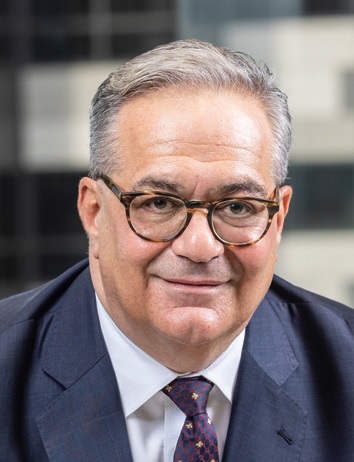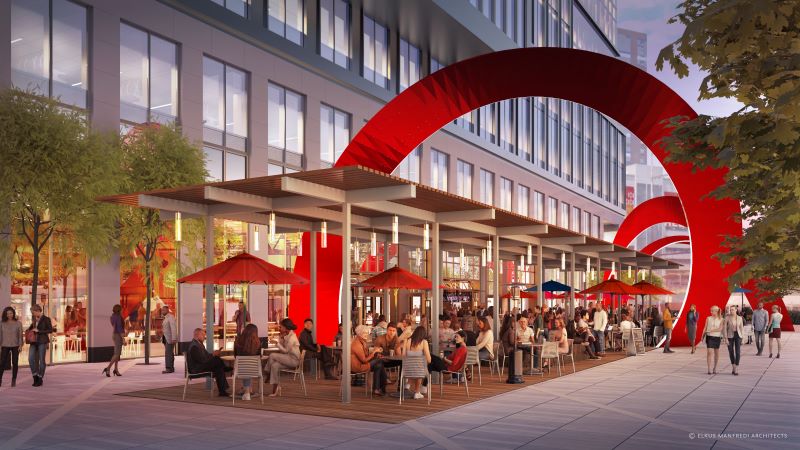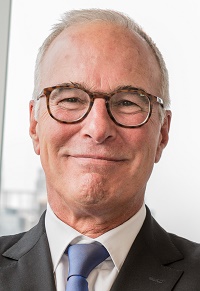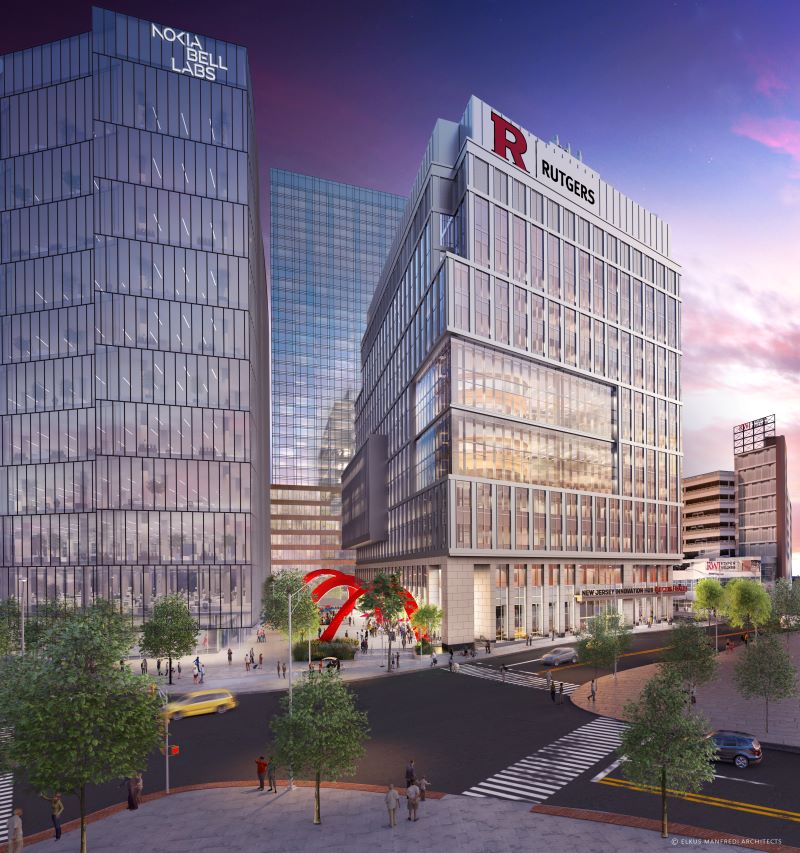Construction is underway on the first phase of the Health & Life Science Exchange in downtown New Brunswick, where plans call for a facility known as the New Jersey Innovation HUB, a new home for the Rutgers Robert Wood Johnson Medical School and a center for translational research. — Renderings by Elkus Manfredi Architects/Courtesy: New Brunswick Development Corp.
By Joshua Burd
It was nearly a year ago that a dozen or so executives with Nokia toured the site of what will become the HELIX, a planned four-acre campus in New Brunswick that will house a mix of health care, life sciences and academic institutions in the heart of the downtown.
It only boded well that the technology giant, in search of a new home for its iconic Bell Labs division, appeared to be well prepared and well versed in all that the city had to offer.

“Without prompting from us, the leadership on that site visit was asking questions and hitting all of the benchmarks that we believe made New Brunswick a strong candidate for this type of project,” said Chris Paladino, president of New Brunswick Development Corp., the master developer for the HELIX property. There was the prospect of being closer to major research universities and the Northeast Corridor, he recalled, plus the ability to recruit the next generation of talent and all that an urban setting has to offer.
“To hear them talk about all of those benchmarks, as opposed to state incentives or what the cost of construction is — leading with those things that are very important to companies but are also strong assets of New Brunswick — led me to be very optimistic from day one,” Paladino said.
That optimism was well founded. In early December, Nokia announced that it would move to the city from its historic Bell Labs campus in the Murray Hill section of Union County, with plans to occupy a built-to-suit, 360,000-square-foot lab and office tower at the HELIX by 2028. It’s slated to do so under a lease with SJP Properties, which will build the facility in partnership with Paladino’s team, marking a signature deal for New Brunswick and for the three-phase, 1 .5 million-square-foot development.
It’s also slated to bring some 1,000 employees to the city in a growing segment of the economy, one that hinges on in-person collaboration, creating a ripple effect beyond a typical office user.

“They looked everywhere,” Gov. Phil Murphy said during a Dec. 11 event in New Brunswick, where Nokia Bell Labs announced its plan for the new facility. “This is not just a question of relocating in the state of New Jersey. They looked around every corner of the United States of America and probably beyond that, and after having assessed all of their alternatives, they landed right here in New Brunswick in the great state of New Jersey. And I think that’s a huge testament, not just to their process, but also what we have to offer.”
The decision is at least five years in the making for Nokia Bell Labs, the firm behind the transistor and other Nobel Prize-winning innovations during 80 years in Murray Hill. For the not-for-profit New Brunswick Development Corp., or Devco, it’s another monumental step in a plan to a transform a parcel just south of Albany Street, across from the New Brunswick train station and steps from Rutgers University, one that would leverage the city’s long-established anchors in health care, government and academia.
The project, officially known as the Health & Life Science Exchange, has taken shape in recent years with strong public support from Murphy, who has highlighted the site in his push to grow the state’s innovation economy. Construction is underway on the first of three phases — a 12-story, 574,000-square-foot building with an incubator known as the New Jersey Innovation HUB, the new home of Rutgers Robert Wood Johnson Medical School and a Rutgers translational research facility.
“That was a very big step,” said Dan Loughlin, a broker and vice chairman with JLL who leads the project’s leasing team, referring to Murphy’s support of the project. “And when Chris and Devco were able to secure Rutgers Medical School, that just gave the site another level of definition and really made the balance of the campus that much more attractive — and I think Nokia picked up on that immediately when they came and visited the campus.”

That visit took place in February, when Nokia executives joined representatives from Devco, SJP Properties and JLL at a site that was one of more than two dozen locations it considered, the company said. But New Brunswick would provide a manageable option for its existing workforce “that was probably more suburban in nature,” Loughlin said, while allowing it to recruit younger talent from New York, Philadelphia and other cities.
It also provided a blank slate for what would be a state-of-the-art, highly specialized facility.

“There was no preconceived design other than a building footprint,” said Loughlin, who represented ownership in the lease alongside JLL’s Blake Goodman, Jason Benson, Dan Spero and Peter Ladas, while Colliers’ Sam Horowitz represented Nokia. Loughlin added: “There was no height restriction, so they were able to really design and implement all of their highly special, technical requirements in a building, which is not easy to do.”
Nokia executives said as much during the Dec. 11 event, noting that the building will rise more than 250 feet despite having just 10 floors. Many floors will be double or triple the height of a typical office building floor, as it continues its work in technologies in areas such as photonics, 6G, artificial intelligence and industrial automation.
That likely made SJP’s involvement even more critical, as a developer that has built out spaces for tech companies such as Qualcomm, iconectiv and others. Steve Pozycki, the firm’s CEO, said his team spent months working with Nokia “to understand their needs” in addition to simply helping them “get them confident on this location.”

“We’re doing a lot in the life science and technology sector because that’s what the market is, so it will be the state-of-the-art building for research and development and electronic labs in the country, if not the world,” Pozycki said. “We’ve looked worldwide, and the vendors that are working with us to be able to deliver what they’re looking for are recruited globally and have worked on things that are similar to this.”
Paladino, for his part, joked that he “had been talking to Steve Pozycki for probably three decades” about partnering on a project. And it was with a broader goal in mind — even beyond attracting Nokia — when Devco and SJP revealed in May that they were teaming up to market the HELIX’s second phase.
“We established a relationship with SJP because we thought they had the right skill set, the right bandwidth and the right reputation to attract a major corporate tenant,” Paladino said. He noted that Devco has focused largely on public-private partnerships in its history. SJP, on the other hand, brings decades of experience in build-to-suits for a long list of blue-chip companies, from Prudential Financial and Panasonic Corp. to Deloitte LLP.
“We could not have actually pulled this off without them,” he added.

Paladino called Nokia’s announcement “one of the four or five most significant events” in New Brunswick’s history, one that’s on par with Rutgers’ founding in 1766, Johnson & Johnson’s founding in 1886 and the company’s decision to stay in the 1970s as other companies fled New Jersey’s cities. Understandably, the news has “accelerated our discussions with a number of potential corporations that we have been dancing with,” he added, creating new momentum for a third phase of the HELIX.
The city will likely build on that momentum as it looks ahead to a 2025 groundbreaking and a projected 2028 opening for Nokia Bell Labs’ new facility.
“By 2028, New Brunswick will be a significantly different place than it is today,” Paladino said. “And it will be another chapter, maybe two chapters, in probably the most significant urban redevelopment story in the country, for a city that was in decline in the ’70s.
“There are some New Jersey cities that have never pulled out of that, but New Brunswick continues to grow in population and it continues to grow in its diversification of job opportunities and communities that it serves. It shows what’s possible when people are on the same page and are supportive of each other.”









